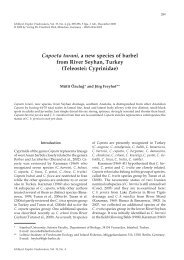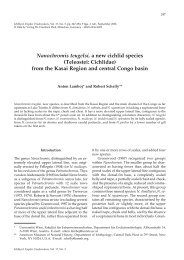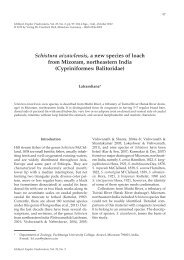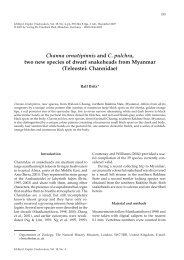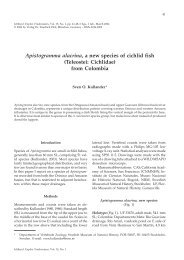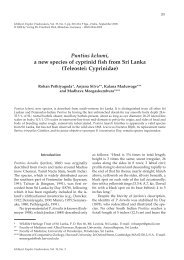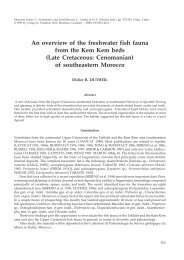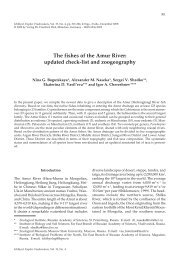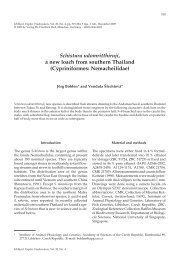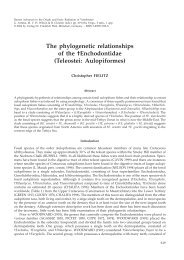A new species of Late Cretaceous osteoglossid - Verlag Dr ...
A new species of Late Cretaceous osteoglossid - Verlag Dr ...
A new species of Late Cretaceous osteoglossid - Verlag Dr ...
You also want an ePaper? Increase the reach of your titles
YUMPU automatically turns print PDFs into web optimized ePapers that Google loves.
Mesozoic Fishes – Systematics and Paleoecology, G. Arratia & G. Viohl (eds.): pp. 285-298, 7 figs.<br />
© 1996 by <strong>Verlag</strong> <strong>Dr</strong>. Friedrich Pfeil, München, Germany – ISBN 3-923871–90-2<br />
A <strong>new</strong> <strong>species</strong> <strong>of</strong> <strong>Late</strong> <strong>Cretaceous</strong> <strong>osteoglossid</strong><br />
(Teleostei) from the Oldman Formation <strong>of</strong> Alberta,<br />
Canada, and its phylogenetic relationships<br />
LI Guo-qing<br />
Abstract<br />
A single specimen <strong>of</strong> Campanian age from the Oldman Formation <strong>of</strong> Dinosaur Provincial Park, Alberta, Canada,<br />
represents a <strong>new</strong> genus and <strong>species</strong> <strong>of</strong> osteoglossomorph fishes. It is thought to be an early member <strong>of</strong> Osteoglossinae<br />
based on the possession <strong>of</strong> five possible synapomorphies <strong>of</strong> the subfamily: 1, opercle subsemicircular in<br />
shape; 2, horizontal arm <strong>of</strong> the preopercle short with its anterior end extending only to the level <strong>of</strong> the posteroventral<br />
corner <strong>of</strong> the third infraorbital; 3, preoperculo-mandibular canal opening in a groove on the horizontal<br />
arm <strong>of</strong> the preopercle; 4, angle <strong>of</strong> jaws posteriorly located; 5, first pectoral fin ray particularly strong and long.<br />
The combination <strong>of</strong> two synapomorphies (anterior portion <strong>of</strong> frontal nearly twice as broad as the posterior portion<br />
and a laterally-compressed deep body with a large pleuroperitoneal cavity) with one other character state (23-25<br />
precaudal vertebrae) suggests that this <strong>new</strong> <strong>Late</strong> <strong>Cretaceous</strong> osteoglossomorph fish is the sister-<strong>species</strong> <strong>of</strong> the<br />
clade including †Phareodus and †Brychaetus.<br />
Introduction<br />
Freshwater teleosts <strong>of</strong> Early <strong>Cretaceous</strong> through middle Paleocene age in North America are extremely<br />
important to studies <strong>of</strong> the evolution <strong>of</strong> the North American fish fauna because this was apparently a time<br />
<strong>of</strong> major biotic transition (GRANDE 1986, GRANDE & CAVENDER 1991). However, materials found so<br />
far from North American <strong>Cretaceous</strong> freshwater deposits are still far from sufficient to clarify the origins<br />
<strong>of</strong> the Cenozoic fish fauna <strong>of</strong> North America. SCHAEFFER (1949) named a freshwater teleost †Ostariostoma<br />
wilseyi on the only specimen collected from the Livingston Formation <strong>of</strong> Montana (Fig. 1). That <strong>species</strong> may<br />
be either <strong>Late</strong> <strong>Cretaceous</strong> or Paleocene in age (SCHAEFFER 1949, GRANDE & CAVENDER 1991). The first<br />
undoubted <strong>Cretaceous</strong> freshwater teleost from North America is †Chandlerichthys strickeri GRANDE 1986,<br />
based on two specimens from the Albian or Cenomanian Chandler Formation <strong>of</strong> northern Alaska (Fig. 1).<br />
Both †Ostariostoma and †Chandlerichthys have been tentatively referred to the supercohort Osteoglossomorpha<br />
(GRANDE 1986, GRANDE & CAVENDER 1991). WILSON et al. (1992) recently described two esocoid<br />
<strong>species</strong> (†Oldmanesox canadensis and †Estesesox foxi) based on fragmentary remains from the Upper <strong>Cretaceous</strong><br />
<strong>of</strong> western North America.<br />
In contrast to the rarity in the <strong>Cretaceous</strong>, teleosts have been found to be the dominant elements<br />
making up several well documented late Paleocene freshwater fish faunas in North America. These late<br />
Paleocene teleosts have been referred to mostly extinct genera within extant taxa such as Ictaluridae<br />
(LUNDBERG 1975), Osteoglossomorpha, Gonorynchidae, Cyprinoidea, Esocidae, Percopsidae, and the<br />
extinct family Asineopidae (WILSON 1980), and Osmeridae (WILSON & WILLIAMS 1991, 1992).<br />
STERNBERG (1941) reported the discovery <strong>of</strong> “<strong>new</strong> teleosts from the Canadian <strong>Cretaceous</strong>” in an<br />
abstract submitted to the proceedings <strong>of</strong> the Royal Society <strong>of</strong> Canada, but the specimens were not described<br />
or named. I am fortunate to examine one <strong>of</strong> the specimens referred to by STERNBERG. It was found<br />
in the Upper <strong>Cretaceous</strong> Oldman Formation <strong>of</strong> southern Alberta, Canada (Fig. 1). My study suggests that<br />
the specimen represents a <strong>new</strong> fossil osteoglossomorph that provides some <strong>new</strong> information about the<br />
phylogeny <strong>of</strong> the Eocene <strong>osteoglossid</strong> †Phareodus.<br />
285
The whole contribution can be<br />
purchased as PDF file.<br />
Availability<br />
Generally all our publications are available as PDF fi les;<br />
full publications as a general rule after the printed version<br />
is out <strong>of</strong> print. If you have questions concerning particular<br />
contributions please contact us by e-mail:<br />
pdf@pfeil-verlag.de.<br />
The PDF files are protected by copyright.<br />
The PDF fi le may be printed for personal use.<br />
The reproduction and dissemination <strong>of</strong> the content or<br />
part <strong>of</strong> it is permitted.<br />
It is not allowed to transfer the digital personal certifi cate<br />
or the password to other persons.<br />
Prices<br />
Books: Prices are to be found in the catalog.<br />
Articles in journals and single contributions or chapters<br />
in books:<br />
10 EURO basic price per order (including the fi rst 10<br />
pages),<br />
and<br />
0.50 EURO per page, beginning with the 11 th page.<br />
Page numbers are found in the contents <strong>of</strong> the publications.<br />
Orders<br />
Use our order form for PDF fi les or send your order informal<br />
per e-mail (pdf@pfeil-verlag.de). The only accepted<br />
payment is by credit card. While using the order<br />
form for PDF files, your data will be transmitted by secure<br />
link (ssl). You also may send the informations informally<br />
by e-mail, fax, phone or mail.<br />
Handling<br />
As soon as possible, depending on our business hours<br />
and your order, you will receive your PDF fi le together<br />
with the certifi cate and password by e-mail.<br />
Larger PDF files can be downloaded from our webspace,<br />
if necessary.<br />
Your invoice will be sent out by e-mail after we charged<br />
your credit card.<br />
To open the encrypted PDF fi les you have to install your<br />
personal certifi cate after your fi rst order. All PDF fi les<br />
with the same certifi cate can be opened from that time<br />
on.<br />
Dieser Beitrag kann als<br />
PDF-Datei erworben werden.<br />
Verfügbarkeit von PDF-Dateien<br />
Prinzipiell sind von allen unseren Publikationen PDF-<br />
Dateien erhältlich. Komplette Publikationen in der Regel<br />
erst nachdem die gedruckte Version vergriffen ist. Anfragen<br />
bezüglich bestimmter Beiträge richten Sie bitte<br />
per E-Mail an pdf@pfeil-verlag.de.<br />
Die PDF-Dateien sind urheberrechtlich geschützt.<br />
Ein Ausdruck der PDF-Dateien ist nur für den persönlichen<br />
Gebrauch erlaubt.<br />
Die Vervielfältigung von Ausdrucken, erneutes Digitalisieren<br />
sowie die Weitergabe von Texten und Abbildungen<br />
sind nicht gestattet.<br />
Das persönliche Zertifikat und das Passwort dürfen nicht<br />
an <strong>Dr</strong>itte weitergegeben werden.<br />
Preise<br />
Bücher: Die Preise sind dem Katalog zu entnehmen.<br />
Zeitschriftenbeiträge und einzelne Kapitel aus Sammelbänden<br />
bzw. Büchern:<br />
10 EURO Grundbetrag pro Bestellung (einschließlich<br />
der ersten 10 Seiten),<br />
und<br />
0,50 EURO pro Seite ab der 11. Seite.<br />
Den Umfang der Beiträge entnehmen Sie bitte den Inhaltsverzeichnissen.<br />
Bestellungen<br />
Bestellungen sind mit dem PDF-Bestellformular oder<br />
formlos per E-Mail (pdf@pfeil-verlag.de) an uns zu<br />
richten. Die Bezahlung ist ausschließlich per Kreditkarte<br />
möglich. Bei Verwendung unseres Bestellformulars<br />
werden die Kreditkartendaten über eine gesicherte<br />
Verbindung (ssl) übermittelt. Sie können die Daten aber<br />
auch formlos per E-Mail, Fax, Post oder telefonisch<br />
übermitteln.<br />
Abwicklung<br />
So bald wie möglich, aber abhängig von unseren Bürozeiten<br />
und der gewünschten Bestellung, schicken wir<br />
Ihnen die PDF-Datei(en) zusammen mit Ihrem persönlichen<br />
Zertifi kat und dem zugehörigem Passwort per<br />
E-Mail. Größere Dateien bieten wir Ihnen gegebenenfalls<br />
zum Herunterladen an.<br />
Der fällige Betrag wird von Ihrer Kreditkarte abgebucht<br />
und Sie erhalten die Rechnung ebenfalls per E-Mail.<br />
Um die verschlüsselten PDF-Dateien öffnen zu können,<br />
muss bei der ersten Bestellung das passwortgeschützte<br />
persönliches Zertifi kat installiert werden, welches<br />
anschließend auf dem Rechner verbleibt. Alle mit diesem<br />
Zertifi kat verschlüsselten Dateien können anschließend<br />
auf diesem Rechner geöffnet werden.





